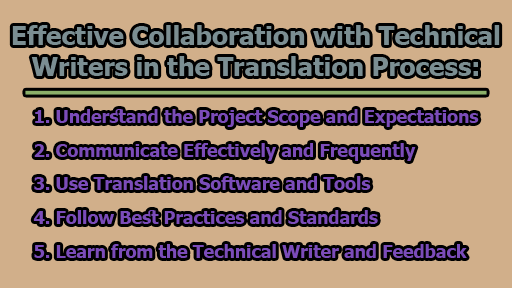Effective Collaboration with Technical Writers in the Translation Process:
Technical translation is a complex and nuanced field, requiring more than just linguistic proficiency. It entails a deep understanding of the subject matter, the context, and the audience of the original document. To achieve accurate, clear, and consistent translations, collaboration with technical writers is essential. In this article, we’ll explore effective collaboration with technical writers in the translation process.
1. Understand the Project Scope and Expectations: Before diving into the translation work, it’s crucial to grasp the full scope and expectations of the project. Some key questions to consider are:
- What is the document’s primary goal and purpose?
- Who is the intended audience, and what are their needs?
- What is the tone and style of the original content?
- How will the translated document be used and distributed?
- What are the project’s deadlines and deliverables?
By answering these questions, you align your translation strategy with the technical writer’s vision and requirements. Additionally, request reference materials such as glossaries, style guides, or previous translations to ensure consistency and quality.
2. Communicate Effectively and Frequently: Effective communication is the cornerstone of successful collaboration. It is essential to maintain a continuous dialogue with the technical writer throughout the translation process, not just at the project’s onset or conclusion. Frequent communication helps in several ways:
- Updates on your progress: Keep the technical writer informed about your progress to ensure transparency and manage expectations.
- Clarification and feedback: If you encounter ambiguities or issues in the source text, do not hesitate to ask for clarification or feedback.
- Reporting issues and challenges: If you encounter difficulties during translation, communicate them promptly to find solutions.
- Requesting changes or revisions: If the translation requires adjustments or updates, seek the technical writer’s input to ensure accuracy.
Use various communication tools such as email, phone, chat, or video conferencing, selecting the most appropriate method based on the urgency and complexity of the message.
3. Use Translation Software and Tools: Translation software and tools can significantly enhance your efficiency and accuracy. Here are some key tools to consider:
- Translation memory: This tool stores previous translations, suggesting matches for new segments. It saves time and ensures consistency across documents.
- Terminology management: Create and maintain a database of terms and definitions to prevent confusion and errors.
- Quality assurance: Check your translation for spelling, grammar, punctuation, formatting, and other issues to enhance professionalism and credibility.
However, it’s important to exercise caution and judgment when using these tools, avoiding blind reliance on them exclusively.
4. Follow Best Practices and Standards: Technical translation adheres to specific best practices and standards to ensure clarity and accuracy. Some key principles to follow include:
- Adherence to the rules and conventions of the target language and culture, such as grammar, syntax, vocabulary, punctuation, and units of measurement.
- Respect for the structure and layout of the original document, including headings, lists, tables, figures, and captions.
- Use of clear and simple language, avoidance of ambiguity and redundancy, and explanation of acronyms and technical terms.
- Careful proofreading and editing, as well as seeking feedback from peers or native speakers.
By adhering to these best practices, you can produce high-quality technical translations.
5. Learn from the Technical Writer and Feedback: Collaborating with a technical writer is not just a means to complete a project but also an opportunity for personal growth and skill enhancement. Be open to learning from the technical writer, who can provide insights and expertise on the subject matter, the audience, and the document.
Furthermore, embrace both positive and negative feedback as a chance to identify your strengths and weaknesses, correct errors, and improve your translation skills. The feedback loop is a valuable aspect of the collaboration that can lead to continuous improvement.
In conclusion, effective collaboration between translators and technical writers is essential for delivering accurate, clear, and consistent technical translations. By understanding project scope and expectations, communicating effectively, using translation tools wisely, adhering to best practices and standards, and embracing feedback, you can ensure successful partnerships and produce high-quality translations that meet the needs of technical content and its audience.

Library Lecturer at Nurul Amin Degree College










